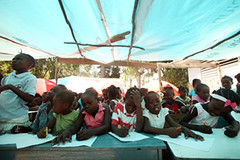
Haiti school children in the northern region of the Caribbean nation. A school collapsed in Cap-Haitien as a result of a landslide on Monday, February 15, 2010.
Originally uploaded by Pan-African News Wire File Photos
05:53 Mecca time, 02:53 GMT
Deaths in Haiti school collapse
Schools in northern Haiti reopened last week following January's devastating quake
At least four children have been killed and several injured after a school collapsed in the town of Cap-Haitien in northern Haiti.
About 200 children were in the school at midday on Monday when the collapse occurred.
Al Jazeera's Todd Baer reporting from the scene said rescuers believe a landslide may have caused a boulder from a nearby hill to crash down onto the roof of one of the classrooms.
He said there had been heavy rains and flooding in the area that could have loosened the soil in the surrounding hills.
Ambulances took several injured children to nearby hospitals, while rescue workers were combing through the rubble looking for any other casualties who may be trapped.
UN peacekeepers and members of the US coast guard were helping with the rescue effort.
Some reports have suggested a small earthquake, possibly an aftershock from last month's deadly magnitude 7 earthquake, may have caused the landslide.
Cap-Haitien is about 130km north of the Haitian capital, Port-au-Prince, where more than 200,000 people are thought to have died in the January quake.
Schools in the north of Haiti reopened last week, although they remain closed in the capital.
Years to rebuild
The latest tragedy to hit the quake-devastated country came as Haiti's president predicted it would take up to three years to clear the rubble from the capital, and many more years to rebuild.
Speaking to the Associated Press, Rene Preval said Haiti faces a drawn out period of reconstruction that will result in far fewer people living in Port-au-Prince.
The January 12 quake has left more than a million people homeless, many of whom now live in makeshift camps or have left the capital for other areas of the country.
Before the quake the Port-au-Prince was home to some 3 million people.
Preval said it would take "1,000 trucks moving rubble for 1,000 days, so that's three years. And until we move out rubble, we cannot really build."
He said the government has destroyed some hastily rebuilt structures in the capital, but added that until alternative housing plans can be completed, the government's ability to regulate reconstruction will be limited.
Government base
On Monday Canada's prime minister began a two-day visit to Haiti, pledging an additional $215m collected from relief campaigns to help the country's reconstruction.
Stephen Harper said Canada would also help build a temporary administrative base for the Haitian government after the quake destroyed several key ministries.
The temporary administrative base will consist of semi-permanent modular shelters and soft-sided inflatable shelters, accommodating key ministries and Haitian civil servants so they can work together on recovery efforts.
"The establishment of a temporary government administrative base is an important step toward early recovery and reconstruction efforts," Harper said after talks with the Haitian president.
He said Canada would provide the base with office equipment and supplies such as computers and desks, as well as electricity, water and cooling systems and sanitation facilities.
Last month's quake destroyed the presidential palace and national assembly and destroyed or damaged several major ministries, forcing Preval and his government to work from a police station and other temporary locations.
"Canada will continue to support the Haitian government as it moves forward with its reconstruction and development agenda," Harper said.
Source: Al Jazeera and agencies
No comments:
Post a Comment